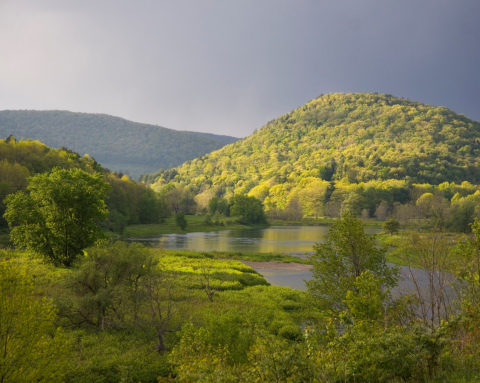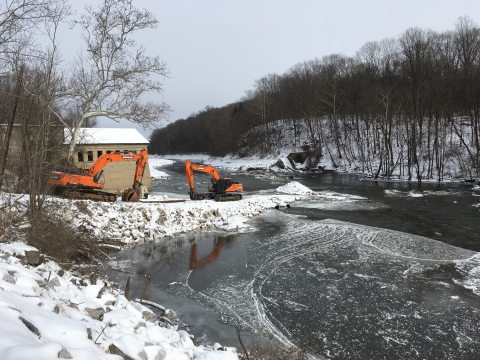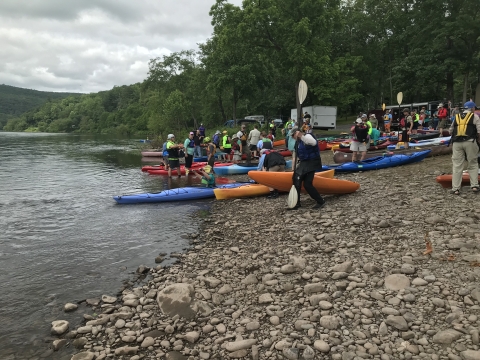What We Do
Our Services
Authorized by Congress with the passage of the 2016 Delaware River Basin Conservation Act, the U.S. Fish and Wildlife Service's Delaware River Basin Restoration Program takes a non-regulatory approach to landscape-scale conservation: it is voluntary, incentive driven, and builds upon existing collaboration by partners throughout the four-state watershed.
The Program reflects a shared vision for conserving and restoring a network of lands and waters to support wildlife, and is guided by a strategic framework developed with partners to focus on conservation in four key areas: reducing flooding and runoff, restoring fish and wildlife habitats, improving water quality, and enhancing safe recreational access for the public.
Read the Delaware River Basin Restoration Program Framework to learn more about the program's vision, strategic goals, and focal areas.
Delaware Watershed Conservation Fund
In 2018, the Service and the National Fish and Wildlife Foundation launched the Delaware Watershed Conservation Fund as the first step toward advancing the goals of the Act. The Fund supports projects that address conservation needs today, and tomorrow. Watch this video to hear from partners about how the fund is helping to advance their work in the watershed.
Delaware River Watershed Conservation Collaborative
In 2021, the Service facilitated the establishment of the Delaware River Watershed Conservation Collaborative (DRWCC), a voluntary partnership that will set funding priorities to ensure investments reflect shared goals and contribute to landscape-scale conservation gains.
Our Projects and Initiatives
The Delaware Watershed Conservation Fund supports a diversity of projects that contribute to the social health and economic vitality of the communities in the Delaware River watershed. These grants will result in significant, measurable benefits for people and wildlife in the watershed.
To date, the fund has awarded $72.1 million to 239 projects that support recreation, water quality, water management, and habitat. The grantees have generated $100 million in match, for a total conservation impact of $172.1 million. Twenty four of those projects have been funded by a historic investment from the Bipartisan Infrastructure Law, which allocated $26 million to the Delaware program in 2021 to invest over the next five years.
Collectively, these projects have already resulted in tangible conservation outcomes, including:
- 26 miles of riparian riparian
Definition of riparian habitat or riparian areas.
Learn more about riparian habitat and 77 miles of streams restored - 1,176 acres of wetlands and 121 acres of floodplain conserved and enhanced
- 6,141 acres with new or improved public access
- 32,522 acres of forest under improved management
You can explore all of the funded projects in our interactive map, or view summaries below of the grant projects that have been funded each year:
- 2018 Delaware Watershed Conservation Fund grant slate
- 2019 Delaware Watershed Conservation Fund grant slate
- 2020 Delaware Watershed Conservation Fund grant slate
- 2021 Delaware Watershed Conservation Fund grant slate
- 2022 Delaware Watershed Conservation Fund grant slate
- 2023 Delaware Watershed Conservation Fund grant slate
- 2024 Delaware Watershed Conservation Fund grant slate
Projects supported by the Fund complement and leverage investments by states and non-profit partners, including through the Highlands Conservation Act Grant Program to support land conservation, and the William Penn Foundation's Delaware River Restoration Fund grants to support restoration.
The National Fish and Wildlife Foundation administers the complementary Delaware River Restoration Fund and the Delaware Watershed Conservation Fund through its Delaware River Program.
Our Laws and Regulations
Signed into law in December 2016, the Delaware River Basin Conservation Act responded to the need for federal, state, and local governments, and regional organizations, to come together to identify, prioritize, and implement restoration activities within the basin.
The Act established the Delaware River Basin Restoration Program, designed to support efforts to implement conservation, stewardship, and enhancement projects in four areas:
- Conserving and restoring fish and wildlife habitat
- Improving and sustaining water quality
- Upgrading water management, and reducing flood damage
- Enhancing recreational opportunities and public access
The program is supported by a diverse array of partners that are committed to a mission to improve ecological integrity throughout the basin, and in so doing, improve the economic health and quality of life for all citizens in the watershed.
Here are some key features of the Program:
- The program is non-regulatory and intended to implement the requirements of the Act through coordinating conservation and restoration activities among partners to improve the efficiency and cost effectiveness of existing and future work.
- The program supports shared strategic priorities through a grant-funding mechanism for projects that will complement existing efforts, as funds are appropriated.
- Program partners established a shared set of priorities to deliver science-based restoration and conservation activities in the Delaware River Basin with willing landowners.
- The program is not intended to replace existing work and associated funding sources in the basin, but rather, to increase coordination between partner agencies, and identify unfunded conservation and restoration priorities in the basin that would be eligible to compete for program funds, as funds are appropriated.









